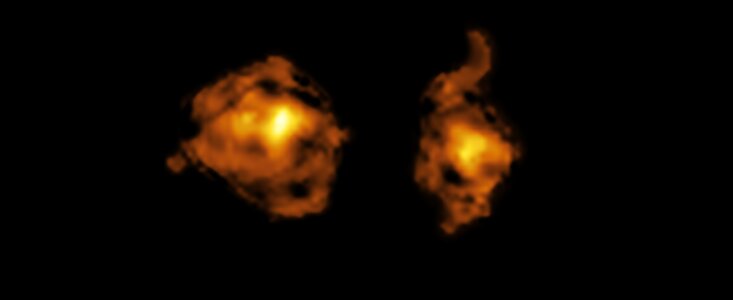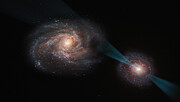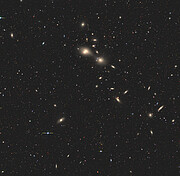Press Release
'Cosmic joust': astronomers observe pair of galaxies in deep-space battle
21 May 2025

Astronomers have witnessed for the first time a violent cosmic collision in which one galaxy pierces another with intense radiation. Their results, published today in Nature, show that this radiation dampens the wounded galaxy’s ability to form new stars. This new study combined observations from both the European Southern Observatory’s Very Large Telescope (ESO’s VLT) and the Atacama Large Millimeter/submillimeter Array (ALMA), revealing all the gory details of this galactic battle.
In the distant depths of the Universe, two galaxies are locked in a thrilling war. Over and over, they charge towards each other at speeds of 500 km/s on a violent collision course, only to land a glancing blow before retreating and winding up for another round. “We hence call this system the ‘cosmic joust’,” says study co-lead Pasquier Noterdaeme, a researcher at the Institut d'Astrophysique de Paris, France, and the French-Chilean Laboratory for Astronomy in Chile, drawing a comparison to the medieval sport. But these galactic knights aren’t exactly chivalrous, and one has a very unfair advantage: it uses a quasar to pierce its opponent with a spear of radiation.
Quasars are the bright cores of some distant galaxies that are powered by supermassive black holes, releasing huge amounts of radiation. Both quasars and galaxy mergers used to be far more common, appearing more frequently in the Universe’s first few billion years, so to observe them astronomers peer into the distant past with powerful telescopes. The light from this ‘cosmic joust’ has taken over 11 billion years to reach us, so we see it as it was when the Universe was only 18% of its current age.
“Here we see for the first time the effect of a quasar’s radiation directly on the internal structure of the gas in an otherwise regular galaxy,” explains study co-lead Sergei Balashev, who is a researcher at the Ioffe Institute in St Petersburg, Russia. The new observations indicate that radiation released by the quasar disrupts the clouds of gas and dust in the regular galaxy, leaving only the smallest, densest regions behind. These regions are likely too small to be capable of star formation, leaving the wounded galaxy with fewer stellar nurseries in a dramatic transformation.
But this galactic victim isn’t all that is being transformed. Balashev explains: “These mergers are thought to bring huge amounts of gas to supermassive black holes residing in galaxy centres.” In the cosmic joust, new reserves of fuel are brought within reach of the black hole powering the quasar. As the black hole feeds, the quasar can continue its damaging attack.
This study was conducted using ALMA and the X-shooter instrument on ESO’s VLT, both located in Chile’s Atacama Desert. ALMA’s high resolution helped the astronomers clearly distinguish the two merging galaxies, which are so close together they looked like a single object in previous observations. With X-shooter, researchers analysed the quasar’s light as it passed through the regular galaxy. This allowed the team to study how this galaxy suffered from the quasar’s radiation in this cosmic fight.
Observations with larger, more powerful telescopes could reveal more about collisions like this. As Noterdaeme says, a telescope like ESO’s Extremely Large Telescope “will certainly allow us to push forward a deeper study of this, and other systems, to better understand the evolution of quasars and their effect on host and nearby galaxies.”
More information
This research was presented in a paper to appear in Nature titled “Quasar radiation transforms the gas in a merging companion galaxy.” (doi: 10.1038/s41586-025-08966-4)
The team is composed of S. Balashev (Ioffe Institute, St Petersburg, Russia), P. Noterdaeme (Institut d’Astrophysique de Paris, Paris, France [IAP] & French-Chilean Laboratory for Astronomy [FCLA], Chile), N. Gupta (Inter-University Centre for Astronomy, Pune, India [IUCAA]), J.K. Krogager (Université Lyon I, Lyon, France & FCLA), F. Combes (Collège de France, Paris, France), S. López (Universidad de Chile [UChile]), P. Petitjean (IAP), A. Omont (IAP), R. Srianand (IUCAA), and R. Cuellar (UChile).
The Atacama Large Millimeter/submillimeter Array (ALMA), an international astronomy facility, is a partnership of ESO, the U.S. National Science Foundation (NSF) and the National Institutes of Natural Sciences (NINS) of Japan in cooperation with the Republic of Chile. ALMA is funded by ESO on behalf of its Member States, by NSF in cooperation with the National Research Council of Canada (NRC) and the National Science and Technology Council (NSTC) in Taiwan and by NINS in cooperation with the Academia Sinica (AS) in Taiwan and the Korea Astronomy and Space Science Institute (KASI). ALMA construction and operations are led by ESO on behalf of its Member States; by the National Radio Astronomy Observatory (NRAO), managed by Associated Universities, Inc. (AUI), on behalf of North America; and by the National Astronomical Observatory of Japan (NAOJ) on behalf of East Asia. The Joint ALMA Observatory (JAO) provides the unified leadership and management of the construction, commissioning and operation of ALMA.
The European Southern Observatory (ESO) enables scientists worldwide to discover the secrets of the Universe for the benefit of all. We design, build and operate world-class observatories on the ground — which astronomers use to tackle exciting questions and spread the fascination of astronomy — and promote international collaboration for astronomy. Established as an intergovernmental organisation in 1962, today ESO is supported by 16 Member States (Austria, Belgium, Czechia, Denmark, France, Finland, Germany, Ireland, Italy, the Netherlands, Poland, Portugal, Spain, Sweden, Switzerland and the United Kingdom), along with the host state of Chile and with Australia as a Strategic Partner. ESO’s headquarters and its visitor centre and planetarium, the ESO Supernova, are located close to Munich in Germany, while the Chilean Atacama Desert, a marvellous place with unique conditions to observe the sky, hosts our telescopes. ESO operates three observing sites: La Silla, Paranal and Chajnantor. At Paranal, ESO operates the Very Large Telescope and its Very Large Telescope Interferometer, as well as survey telescopes such as VISTA. Also at Paranal ESO will host and operate the Cherenkov Telescope Array South, the world’s largest and most sensitive gamma-ray observatory. Together with international partners, ESO operates ALMA on Chajnantor, a facility that observes the skies in the millimetre and submillimetre range. At Cerro Armazones, near Paranal, we are building “the world’s biggest eye on the sky” — ESO’s Extremely Large Telescope. From our offices in Santiago, Chile we support our operations in the country and engage with Chilean partners and society.
Links
- Research paper
- Photos of the VLT
- Photos of ALMA
- Find out more about ESO's Extremely Large Telescope on our dedicated website and press kit
- For journalists: subscribe to receive our releases under embargo in your language and apply to take part in ESO's (partly funded) 2025 strategic media visit (NEW)
- For scientists: got a story? Pitch your research
- New ESO analysis confirms severe damage from industrial complex planned near Paranal
Contacts
Pasquier Noterdaeme
Institut d'Astrophysique de Paris
Paris, France
Tel: +33 1 44 32 81 65
Email: noterdaeme@iap.fr
Sergei Balashev
Ioffe Institute
St Petersburg, Russia
Tel: +7 921 970 2553
Email: s.balashev@gmail.com
Bárbara Ferreira
ESO Media Manager
Garching bei München, Germany
Tel: +49 89 3200 6670
Cell: +49 151 241 664 00
Email: press@eso.org
Our use of Cookies
We use cookies that are essential for accessing our websites and using our services. We also use cookies to analyse, measure and improve our websites’ performance, to enable content sharing via social media and to display media content hosted on third-party platforms.
ESO Cookies Policy
The European Organisation for Astronomical Research in the Southern Hemisphere (ESO) is the pre-eminent intergovernmental science and technology organisation in astronomy. It carries out an ambitious programme focused on the design, construction and operation of powerful ground-based observing facilities for astronomy.
This Cookies Policy is intended to provide clarity by outlining the cookies used on the ESO public websites, their functions, the options you have for controlling them, and the ways you can contact us for additional details.
What are cookies?
Cookies are small pieces of data stored on your device by websites you visit. They serve various purposes, such as remembering login credentials and preferences and enhance your browsing experience.
Categories of cookies we use
Essential cookies (always active): These cookies are strictly necessary for the proper functioning of our website. Without these cookies, the website cannot operate correctly, and certain services, such as logging in or accessing secure areas, may not be available; because they are essential for the website’s operation, they cannot be disabled.
Functional Cookies: These cookies enhance your browsing experience by enabling additional features and personalization, such as remembering your preferences and settings. While not strictly necessary for the website to function, they improve usability and convenience; these cookies are only placed if you provide your consent.
Analytics cookies: These cookies collect information about how visitors interact with our website, such as which pages are visited most often and how users navigate the site. This data helps us improve website performance, optimize content, and enhance the user experience; these cookies are only placed if you provide your consent. We use the following analytics cookies.
Matomo Cookies:
This website uses Matomo (formerly Piwik), an open source software which enables the statistical analysis of website visits. Matomo uses cookies (text files) which are saved on your computer and which allow us to analyze how you use our website. The website user information generated by the cookies will only be saved on the servers of our IT Department. We use this information to analyze www.eso.org visits and to prepare reports on website activities. These data will not be disclosed to third parties.
On behalf of ESO, Matomo will use this information for the purpose of evaluating your use of the website, compiling reports on website activity and providing other services relating to website activity and internet usage.
Matomo cookies settings:
Additional Third-party cookies on ESO websites: some of our pages display content from external providers, e.g. YouTube.
Such third-party services are outside of ESO control and may, at any time, change their terms of service, use of cookies, etc.
YouTube: Some videos on the ESO website are embedded from ESO’s official YouTube channel. We have enabled YouTube’s privacy-enhanced mode, meaning that no cookies are set unless the user actively clicks on the video to play it. Additionally, in this mode, YouTube does not store any personally identifiable cookie data for embedded video playbacks. For more details, please refer to YouTube’s embedding videos information page.
Cookies can also be classified based on the following elements.
Regarding the domain, there are:
- First-party cookies, set by the website you are currently visiting. They are stored by the same domain that you are browsing and are used to enhance your experience on that site;
- Third-party cookies, set by a domain other than the one you are currently visiting.
As for their duration, cookies can be:
- Browser-session cookies, which are deleted when the user closes the browser;
- Stored cookies, which stay on the user's device for a predetermined period of time.
How to manage cookies
Cookie settings: You can modify your cookie choices for the ESO webpages at any time by clicking on the link Cookie settings at the bottom of any page.
In your browser: If you wish to delete cookies or instruct your browser to delete or block cookies by default, please visit the help pages of your browser:
Please be aware that if you delete or decline cookies, certain functionalities of our website may be not be available and your browsing experience may be affected.
You can set most browsers to prevent any cookies being placed on your device, but you may then have to manually adjust some preferences every time you visit a site/page. And some services and functionalities may not work properly at all (e.g. profile logging-in, shop check out).
Updates to the ESO Cookies Policy
The ESO Cookies Policy may be subject to future updates, which will be made available on this page.
Additional information
For any queries related to cookies, please contact: pdprATesoDOTorg.
As ESO public webpages are managed by our Department of Communication, your questions will be dealt with the support of the said Department.






